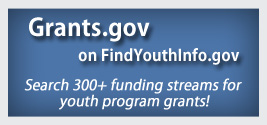Share Your Voice - Provide Input
You are here
Home ›Summer 2012 Update: The Interagency Working Group on Youth Programs (Working Group) is developing a draft strategic plan incorporating the stakeholder input received through ten public listening sessions held across the country, which aligns with key federal strategic plans and coordination activities. We anticipate that the draft plan will represent an initial step in identifying strategies for federal collaboration and provides a basis for future actions related to positive outcomes for youth. When available, the draft plan will be posted here for public comment. Please check back soon to review the document and offer feedback, or subscribe to our electronic newsletter to receive biweekly updates.
The Working Group is developing a strategic plan for Federal youth policy. The Working Group is focusing on youth across several developmental stages, including:
- Early adolescence (ages under 14)
- Middle adolescence (ages 15-17)
- Late adolescence/early adulthood (ages 18-24)
The Working Group is focusing on three overarching outcomes for youth through this framework:
- Basic needs: health, safety, and wellness
- School, family, and community engagement and connections
- Education, training, employment, transitions, and readiness for careers and adulthood.
Stakeholders at the Federal, state, and local levels had several opportunities to offer input into the overall strategic plan for Federal youth policy. Stakeholder input was received through ten public listening sessions that were held across the country from May 2010 to December 2010, sessions held in conjunction with youth-focused conferences, webinars targeted at specific groups, and sessions with youth. A Federal Register notice solicited comments from the public as well.
Examples of participants at the different sessions include:
- Youth
- Non-profit and community-based organizations, including youth-focused organizations and partnerships
- State children’s cabinets and other state stakeholders
- Faith-based organizations
- Funders
- Researchers
- Comprehensive city initiatives
- Colleges and universities
- Federal and national level stakeholders
- Foundations
Below you can read summaries of participants’ responses at each of the public listening sessions. Each public listening session focused on a different youth topic from the framework, but the input received from participants addressed related topics as well.
You can weigh in on the public comments, or add your own ideas, using the input box below.
- Listening Session Summary: Focus on Education, (Boston, MA)
- Listening Session Summary: Focus on Service-Learning, Youth Engagement and Enrichment Opportunities, (New York, NY)
- Listening Session Summary: Focus on Improving Outcomes for All Youth, (Washington, DC)
- Listening Session Summary: Focus on Juvenile Justice, (Orlando, FL)
- Listening Session Summary: Focus on Youth Employment and Transitions, (Chicago, IL)
- Listening Session Summary: Focus on Housing, (Houston, TX)
- Listening Session Summary: Focus on Physical and Mental Health and Wellness, (Kansas City, MO)
- Listening Session Summary: Focus on Service-Learning and Youth Engagement, (Denver, CO)
- Listening Session Summary: Focus on Youth Enrichment, Youth Engagement, Youth Mentoring, and Positive Youth Development, (San Francisco, CA)
- Listening Session Summary: Focus on Youth Safety, (Seattle, WA)
In addition to the public listening sessions, sessions were held at seven youth related conferences across the country. These sessions gathered additional information from targeted participants who work with youth and families to address homelessness, mental health issues, transitions, health, positive youth development and other targeted topics. While common themes were seen across the sessions, some responses varied by the specific interests of those participating. You can weigh in on the conference session comments, or add your own ideas, using the input box below.
Conference Listening Session Summaries
Six sessions with youth were held to ensure that the youth voice was captured in the strategic planning process. Sessions were held with youth that represented different youth organizations. Most sessions co-occurred with conferences and events targeted at youth. Participants included youth leaders from 4-H organizations, youth involved in the Special Olympics, youth who attended and participated in a national bullying summit, youth involved in systems of care, youth who attended a summit on traffic safety, and youth who participated in a summit on foster care in California. Each of the sessions held with youth are summarized separately as different questions were asked at the sessions. You can weigh in on the conference session comments, or add your own ideas, using the input box below.
Youth Listening Session Summaries
The Children's Cabinet Network session was made up of state policy leaders who serve as directors and/or chairs of Children's Cabinets. Sometimes known as councils or commissions, Children's Cabinets are established through executive order or legislation. Though they vary in structure from state to state, Children's Cabinets are typically made up of the heads of all state government agencies with child and youth-serving programs. Members of Children's Cabinets meet on a regular basis to coordinate services, develop a common set of outcomes, and collaboratively decide upon and implement plans to foster the well-being of young people in their state. The Children's Cabinet Network expressed ways in which federal policy can help improve their coordination efforts at the state level, so that they may more efficiently and effectively improve youth outcomes. You can weigh in on the Children’s Cabinet Network session comments, or add your own ideas, using the input box below.

















